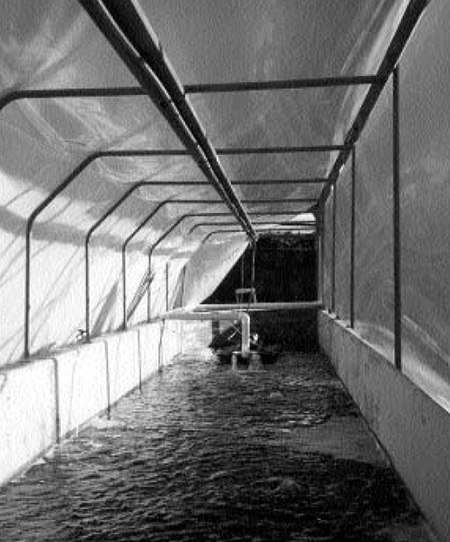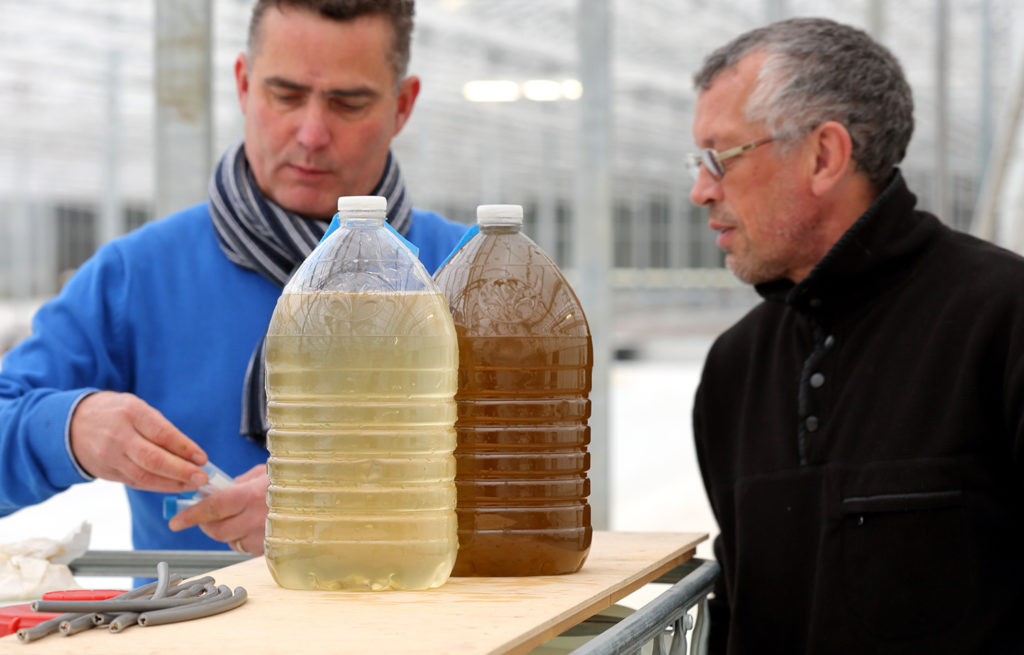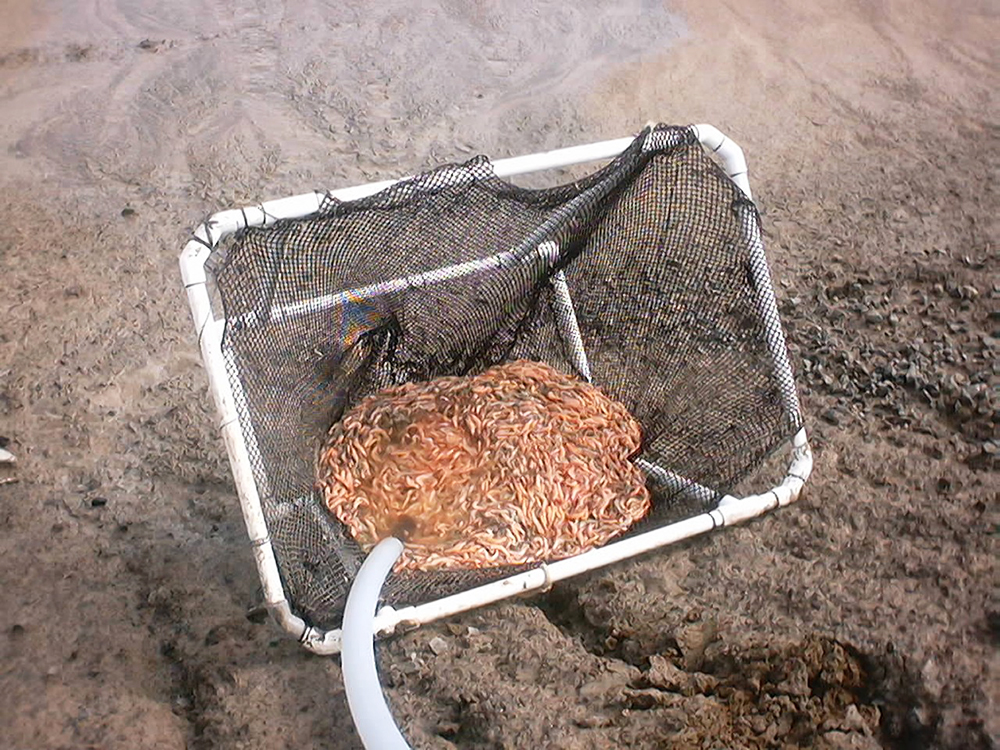Selective breeding and development of appropriate feeds are priorities
 Successful food production industries such as the poultry industry rely on advanced technologies to mitigate crop loss due to disease. These industries depend on high-health, genetically improved stocks reared in environmentally controlled production systems designed for pathogen exclusion. In contrast, most marine shrimp farmers rely on wild-caught seed stocked into large, outdoor ponds constructed along the coast.
Successful food production industries such as the poultry industry rely on advanced technologies to mitigate crop loss due to disease. These industries depend on high-health, genetically improved stocks reared in environmentally controlled production systems designed for pathogen exclusion. In contrast, most marine shrimp farmers rely on wild-caught seed stocked into large, outdoor ponds constructed along the coast.
With these methods, shrimp farmers produced an estimated 737,200 metric tons of shrimp in 1998, and this production represents about 25 percent of the total shrimp production worldwide. However, shrimp aquaculture production declined by about 10 percent between 1994 and 1997, and lower production has been largely attributed to viral pathogens.
Shrimp viruses have devastated the global shrimp farming industry in recent years, resulting in significant economic losses. Mortalities of cultured shrimp due to White Spot Syndrome Virus (WSSV) continue to occur in the major shrimp farming regions in Asia, and this virus has now been confirmed in the Americas, including Ecuador. Until recently, Taura Syndrome Virus (TSV) was restricted to shrimp farms in the Western Hemisphere, but it has now been identified in Taiwan where it has been implicated in contributing to mass mortalities of cultured shrimp.
Although vaccines, medicated feeds, and immunostimulants are effective in combating some pathogens in other meat-producing industries, they are either unavailable to shrimp farmers or their efficacy is unproven. Various pond management strategies have been employed to mitigate the risk of disease outbreak, including the stocking of high-health seed, reducing water exchange rates, and screening influent water. Unfortunately, these are not effective disease prevention strategies in large, outdoor production ponds. Genetic selection may enhance disease resistance in farmed plants and animals, including fish.
Until recently, the efficacy of breeding for disease resistance in penaeid shrimp was not well established because of the paucity of information about relevant genetic parameters. However, in response to viral disease problems facing the shrimp farming industry, the Oceanic Institute (OI), through funding from the U.S. Department of Agriculture, developed a selective breeding program using specific pathogen free (SPF) Pacific white shrimp, (Litopenaeus vannamei). Over 500 full-sib families have been evaluated for growth and TSV resistance, and results indicate that there is high between-family variation in response to TSV challenge. However, heritability (h2) estimated over eight generations was 0.09 + 0.03 and ranged from -0.04 + 0.01 to 0.30 + 0.07 (h2half-sib + SE). Estimates of h2 typically are low for fitness traits, such as disease resistance, and traits with h2 less than 0.15 are difficult to improve by selection.
In light of the limitations in breeding for disease resistance, selective breeding should not be perceived as a panacea to the health problems plaguing the shrimp farming industry. For shrimp farmers to meet the growing demand for high-quality shrimp products, novel production systems must be designed to minimize the introduction and spread of pathogenic agents, as well as to protect coastal resources.
Biosecure shrimp production systems represent an emerging technology that provides a high degree of pathogen exclusion with minimal water exchange. Most research on closed recirculating systems has focused on maintaining high quality water. These systems depend on various types of filters to remove suspended solids that can damage fish gills, increase biological oxygen demand, and contribute to the production of toxic nitrogenous wastes. However, shrimp reared in clean, filtered seawater grow poorly compared to shrimp reared in pond water rich in microalgae and microbial- detrital aggregates.
In an effort to develop biosecure technologies for the U.S. shrimp farming industry, OI is evaluating a prototype biosecure system for the production of L. vannamei. The system consists of a covered, 58-square-meter raceway that allows for the continuous flow of water in a circular pattern around a central baffle. Water flow produces a scouring velocity to keep solids in suspension. An aspiratortype aerator is used sparingly to provide both aeration and water movement. For water filtration, a 25-cubic-foot bead filter is used for solids removal and biological nitrification. The bead filter allows a sufficient amount of microalgae to pass through so that a “green water” environment can be maintained.
Shrimp production data from this system are encouraging. In an initial trial, 1.0-gram shrimp were stocked at a density of 140 per square meter and grown to market size of 22 grams in 14 weeks. Shrimp production was 1.74 kilograms per square meter, mean growth rate was 1.5 grams per week, and water was replaced at a rate of 2.4 percent per day. In a second trial, 1.9-gram shrimp were stocked at a density of 100 per square meter and grown to market size of 23 grams in 16 weeks. Shrimp production was 1.99 kilograms per square meter, mean growth rate was 1.32 grams per week, and water was replaced at a rate of less than 0.5 percent per day.
Despite these encouraging results, important advances need to occur before this technology becomes commercially viable. Two critical areas of research include: 1) selective breeding of shrimp for rapid growth and high survival in biosecure production systems, and 2) the development of aquatic feeds appropriate for biosecure systems. Currently, OI is devoting significant resources to these research areas. With advanced biosecure technologies available, the shrimp farming industry will be able to expand into areas away from the coast with greater control against the spread of disease and without adversely affecting the environment.
(Editor’s Note: This article was originally published in the August/October 1999 print edition of the Global Aquaculture Advocate.)
Now that you've reached the end of the article ...
… please consider supporting GSA’s mission to advance responsible seafood practices through education, advocacy and third-party assurances. The Advocate aims to document the evolution of responsible seafood practices and share the expansive knowledge of our vast network of contributors.
By becoming a Global Seafood Alliance member, you’re ensuring that all of the pre-competitive work we do through member benefits, resources and events can continue. Individual membership costs just $50 a year.
Not a GSA member? Join us.
Author
-
Dr. Shaun M. Moss
The Oceanic Institute
41-202 Kalanianaole Hwy.
Waimanalo, HI 96795 USA[109,111,99,46,108,105,97,109,116,110,101,103,105,108,101,116,64,115,115,111,109,115]
Tagged With
Related Posts

Responsibility
A look at various intensive shrimp farming systems in Asia
The impact of diseases led some Asian shrimp farming countries to develop biofloc and recirculation aquaculture system (RAS) production technologies. Treating incoming water for culture operations and wastewater treatment are biosecurity measures for disease prevention and control.

Innovation & Investment
Algae innovators aim to freeze out early-stage shrimp losses
A greenhouse in Belgium believes its innovative shrimp feed product, made from freeze-dried microalgae, packs the necessary nutrients for the crustacean’s most vulnerable life stage: the first three days of its life.

Health & Welfare
Biofloc technology: Possible prevention for shrimp diseases
Facing emerging viral problems and rising energy costs, the use of biofloc technology in biosecure systems offers an answer for sustainable shrimp aquaculture. The main attributes of biofloc systems in reducing disease risk include the fact that low water exchange improves pathogen exclusion.

Aquafeeds
Biosecurity protocols needed for shrimp feeds, feeding practices
Shrimp aquafeeds – live, fresh or formulated – should not be an entry point of potential pathogens to the shrimp and/or to their culture systems.



